Support strong Canadian climate journalism for 2025
Part two in a two-part series. Read part one here.
It’s been a long and winding road for glyphosate, the active ingredient in the herbicide called Roundup.
Today, Roundup is used on crops around the world and is a foundational component of industrial farming, but its story starts in the 1950s when chemists were searching for useful compounds that could be patented, because patenting affords a monopoly on sales rights, and the potential for massive windfall profits.
The original 1950 patent for glyphosate was registered by a Dr. Henri Martin. Martin worked for a small Swiss company called Cilag. Nothing much came of his efforts.
The patent languished as it was sold back and forth from one research company to another until if ended up with the Stauffer Chemical Company in New York. Stauffer is one of nearly 300,000 companies incorporated in Delaware, a small state with a big reputation for corporate-friendly laws.
In 1964 Stauffer applied for and received US Patent 3,160,632 for “Aminomethylenephosphinic acids, salts thereof, and process for their production”. The primary identified function of this group of chemicals was their action as “chelating agents”. These are substances that grab and hold tightly onto metal ions, rendering them unavailable for chemical reaction with surrounding materials. Adding traces of a strong and necessarily non-toxic chelating agent to canned foods, for example, means that metal leaching from the can won’t degrade the flavour of the food.
In pipes and boilers, chelating agents chemically bind to minerals – like the calcium in “hard” water – that become encrusted on their inner surfaces. This allows them to be more readily swished away.
Multiple compounds in Stauffer’s patented chemical group were tested for this property and all performed well. The patent document, however, also made an enigmatic reference to the compounds being “biologically active." One compound in this group effectively killed off a parasitic soil worm.
Enter Monsanto
Perhaps that’s what eventually caught the eye of Monsanto, a company founded in 1901 by John Francis Queeny, who named it after his wife, Olga Monsanto.
Monsanto’s first product was the artificial sweetener saccharin, which itself has had a chequered history.
Monsanto soon expanded into other products like artificial vanilla flavouring and industrial chemicals. Then it explored and developed plastic products in the 1940s. Later, the company produced DDT, PCBs, Agent Orange and bovine growth hormone, all of which were eventually banned or severely restricted.
In the process, Monsanto has become adept at the practice of profiting extensively from a particular product, but when it is found to cause harm, stepping away from it just before an alarmed regulator brings down the hammer.
In a more positive development, Monsanto was the first company to mass produce LEDs, pioneering the devices in 1968. As a result of the wide acceptance of LEDs, the company experienced rapid sales growth for the next few years. In 1974, about the time it was ready to unleash Roundup/glyphosate on the world, it was able to give a ten-year industrial research grant to Harvard University, a full six years before the controversial Bayh-Dole Act allowed academic institutions to patent any inventions their researchers had developed, thus giving publicly-funded research a decidedly privatized twist.
Monsanto’s emphasis on chemical products was gradually supplanted by a new focus on agriculture and biotechnology. In the middle of this transition, it acquired the patent on glyphosate.
Initially, like Stauffer, Monsanto scientists looked for an effective chelating agent. But chemist John Franz, a lifelong Monsanto employee, took an interest in its “biologically active” properties. And after a years-long program of diligent and wide-ranging exploratory and proprietary experimentation, and the acquisition of a string of Monsanto-held patents, the product Roundup went on sale in 1974.
Gone were all references to chelation or any other attribute of the chemical. Gone also were any references to the chemical’s earlier developers. Monsanto simply claimed that its own scientists had “invented” the chemical, despite two decades of evidence of prior development and analysis.
Glyphosate was now portrayed as the premier plant-killer. As the Monsanto website proclaims to this day: “Roundup….allowed farmers to kill almost every weed that emerged from the soil…[it] seemed to be the perfect environmental solution at the perfect time….and was found to be safe for humans and wildlife. Environmentally speaking, [it] proved to be one of, if not the safest, herbicides in history.”
A series of videos, documenting the company’s version of history on the Monsanto website, refers to glyphosate and Roundup repetitively as “environmentally friendly”.
Despite Monsanto’s strict focus on the concept that Roundup was “environmentally friendly”, its primary attribute, they found, was that it killed all plants – not just weeds, but crops farmers intended for sale as well.
Nick Reding, former President of Monsanto’s Ag Division, states clearly how this attribute affected Monsanto staff. In a video on the Monsanto website, he notes ruefully that it generated “consternation about whether we really knew what we had on our hands.”
Consternation or not, the company responded with a tidal wave of marketing creativity. Its marketers and scientists worked together to outline ingenious uses that spared food crops, while destroying plants that impaired farmers’ earnings or increased their workload. The voiceover on a grainy video from the 1970s declares proudly – and prophetically – that Roundup, “a major product of the future, will have extensive worldwide application in plantation as well as crop agriculture.”
The smokescreen
To sell such a substance, Monsanto needed to create a fable of safety.
Roundup/glyphosate was presented, from the beginning of its marketing career till today, as perfectly safe for humans on the grounds that the one and only process in living things that it interrupted is absent in humans.
The way glyphosate was postulated to work – and the only way – was laid out relentlessly in public relations campaigns and published studies. The talking points were then echoed by other plant scientists to the almost complete exclusion of reference to any other effects. Even the Wikipedia entry on “Glyphosate” presents Monsanto’s fable as the primary mechanism by which glyphosate affects plants.
The singular mechanism which the world was urged to accept was damage to an enzyme called EPSPS (5-enolpyruvylshikimate-3-phosphate synthase, if you must know) involved in a biochemical process called the shikimate pathway. EPSPS is found in plants but not in animals. (This pathway is also found in a number of bacteria and fungi – glyphosate therefore functions as an antibiotic, as it turns out. More on that later.)
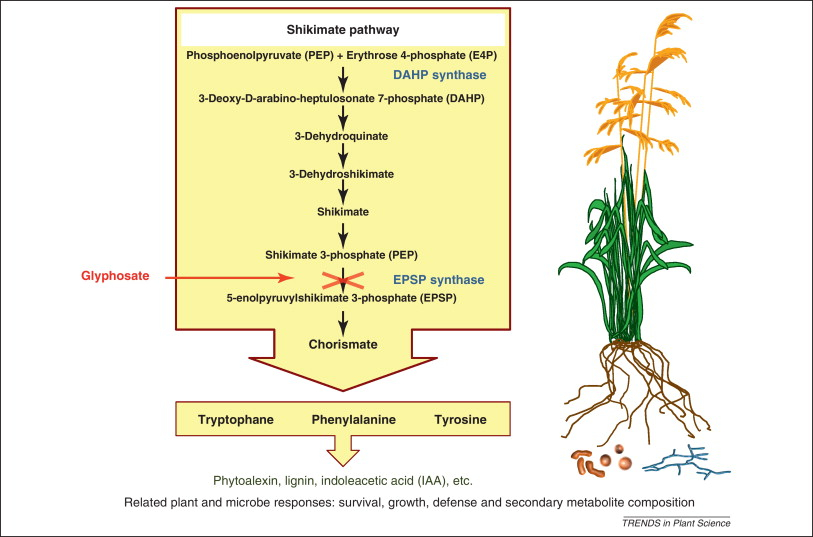
The shikimate pathway generates three key amino acids, phenylalanine, tyrosine and tryptophan, of great importance as building blocks of critical plant proteins. Without them, a plant withers and dies.
Monsanto’s advertising, public relations and in-house “research” hammered home the message about glyphosate’s effect on the shikimate pathway, designating it as the chemical’s mode of action, to the virtual exclusion of any mention of other attributes.
Scientists challenge glyphosate
In recent years, this public relations sleight-of-hand is steadily being exposed. Its collapse is revealing a multitude of other intrusive and harmful effects caused by glyphosate, and even more by the preparation called Roundup.
Several independent scientific voices have been seminal in challenging the simplistic and benign image of glyphosate that Monsanto has worked so hard to create.
The first voice belongs to retired plant scientist Dr. Don Huber, a professor of plant pathology with a 35 year academic history at Purdue University , and a long publication history. After his retirement, Huber began bringing forth evidence that glyphosate might potentially well be doing something far worse than simply inactivating the shikimate pathway.
He reaffirmed that glyphosate was a originally developed as a chelating agent that sequestered minerals in soil and plants – and animals – and made them unavailable for physiological functions.
He also began to address the antibacterial and antifungal actions of glyphosate, which Monsanto had previously patented, but then ignored (or, in interest of the chosen message about just affecting EPSPS, more or less suppressed). And he also advanced evidence that glyphosate didn’t just break down quickly in soil, but was actually incorporated into plants and passed on to people eating them – something that is now well-documented.
A second and more cogent voice belongs to two biological scientists with a combination of experience and technical knowledge that has allowed them to reach deep inside Monsanto’s world of fable, and lay out the distortions in the company’s “official” story line around Roundup/glyphosate.
Anthony Samsel and Stephanie Seneff come from different career paths. But they share strong convictions about the importance of ethics of science, and the perils of conflict-of-interest in shaping public conduct.
Samsel is an environmental scientist who for 13 years worked for ADL, a management consultancy that claims to be the oldest company in its field, having been founded by MIT chemist Arthur D. Little (hence the initials ADL) in 1886.
Samsel advised businesses and governments on waste and water management, toxic cleanup, and various chemical technologies. While at ADL he also set up in 1976 a private scientific consulting business that he still runs today.
Samsel has carried out community investigations of industrial polluters of air and water by hazardous chemical materials, as well as research into agricultural pollution by pesticides, biocides, genetically engineered materials and their effects on public health and the environment.

Seneff, on the other hand, is a biophysicist who focused for many years on computer science. She is now a senior research scientist at the MIT Computer Science and Artificial Intelligence Laboratory. She has written 170 papers in the field of artificial intelligence and language patterns and spoken widely in this field. But she had always kept up her interest in biology.
A few years ago, she returned to those roots, driven by a personal interest in the neurophysical condition called autism. She speculates that it might be possible for autism to be linked to glyphosate, after being inspired by a presentation by Dr. Don Huber. She later got in contact with Anthony Samsel, and they produced their first paper together in 2013.

What the two have done has dismayed Monsanto and its followers.
They have identified a range of effects of glyphosate on human and other mammalian metabolism other than the effect on the EPSPS, effects such as a profound suppression of a class of enzymes found in the liver for detoxifying substances we ingest, and impairment of certain metabolic transport mechanisms that underlie critical biochemical pathways in our bodies.
Based on these effects, they have gone on to speculate about a range of illnesses or disturbances that have been emerging or increasing since the late 20th century.
“Correlation does not mean causation”, i.e. two events occurring at the same time does not prove that one caused the other.
Nevertheless the ubiquity of glyphosate and the vast quantities of the chemical diffused into the environment is now found in an astonishing range of foods and products as well as in the bodies of most people who have been tested in the industrial world. This implies at the very least that the potential for widespread damage needs to urgently be explored.
For a large corporation that has made $4 billion from sales of Roundup/glyphosate in 2015, this is not good news.
Making the connection
The other independent voice calling Roundup/glyphosate to task belongs to Thierry Vrain, a French plant physiologist who trained in Caën (the same city where leading glyphosate researcher Gilles-Eric Séralini now works). Vrain came to Canada in the early 1970s, taught at the Université de Montréal for a short time, and then went on to earn a PhD in soil biology at North Carolina State University in 1977, with a focus on the study of nematode worms. These worms are widely considered to be the most abundant life form on earth. They live in soil and water and cause benefit or harm to a variety of plants and animals, including humans. Roundworms, pinworms, hookworms and whip worms all belong to this class of creature.
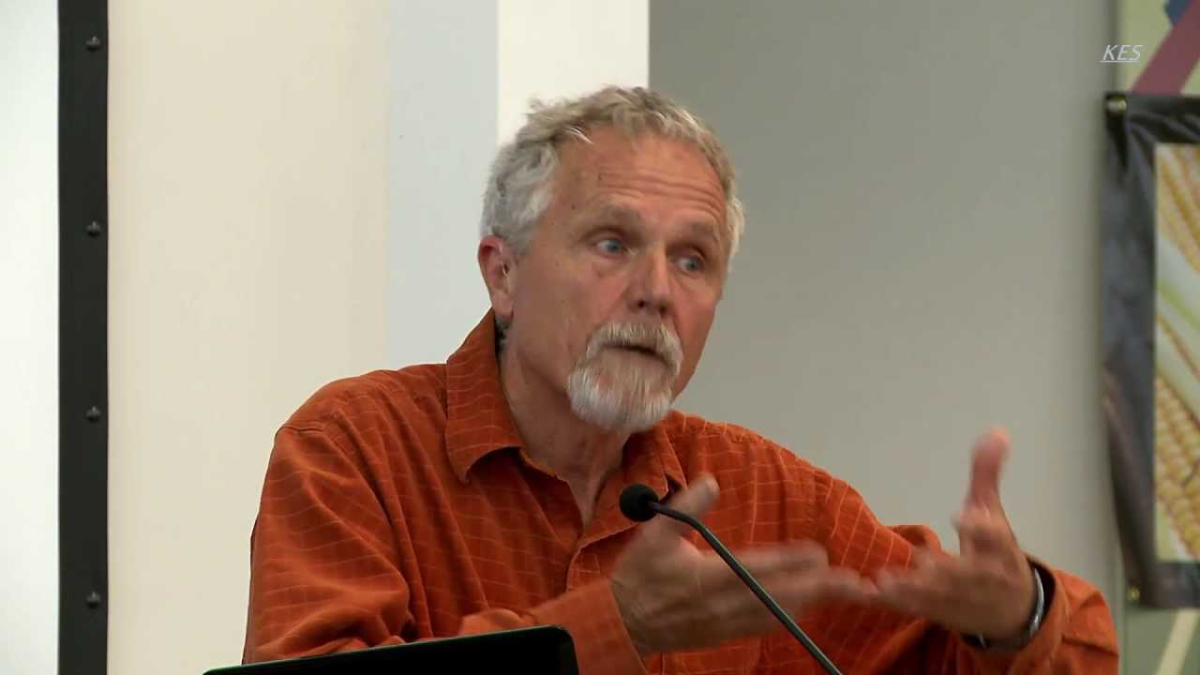
Vrain worked in agriculture research for the Canadian government, publishing 84 papers, seven book chapters and 132 abstracts and technical summaries. He spent his last six years in charge of biotechnology at the Pacific Agri-Food Research Centre in Summerland, B.C., before his retirement in 2003. He now owns a small organic farm on Vancouver Island.
Vrain began making presentations and writing articles suggesting that the real problem with genetically-engineered food crops is not the gene-insertion technology itself, which had been used in contained systems for a number of years before it was expanded to use in food crops.
The real hazard arises, he suggests, from the all-pervasive use of Roundup that is necessary to making genetically-engineered crops functional. Today, 90 per cent of all GMOs live or die by the presence of glyphosate, because they are made to be "Roundup Ready."
This point, which Vrain has made in his many public presentations in Canada and the US and elsewhere (over 30 to date), and in a TEDx talk in 2013, is something which Monsanto, and its business partners, have continuously downplayed.
To have a reputable scientist with impeccable credentials in public service saying this has undoubtedly perplexed the company’s PR team, which has used character assassination in the past to try and neutralize critics.
Samsel and Seneff, Vrain, and Don Huber are all qualified, well-respected and experienced in the world of science.
Each has impressive practical knowledge of biological processes.
They've been the target of op-eds, articles, press releases, web sites, and organized paid expert supporters to mount a chorus of resistance against the three critics in campaigns much like the one it launched against critic Gilles-Eric Séralini.
Monsanto worked with large biotech companies to set up a web site called “GMO answers.”
"GMO answers" attacked the researchers, questioning their credentials and counterbalancing their arguments with in-house studies claiming Roundup's harmlessness (often without revealing their connection to the company).
The website says it has the support of several partners, including industry lobby groups as well as the American Council on Science and Health (ACSH), a non-profit group that says it is dedicated to educating the public about peer-reviewed science, but earned the unflattering sobriquet from consumer advocate Ralph Nader of “a consumer front organization for its business backers.”
Editor's Note: After this article and the first part of this series first appeared, National Observer received a series of tweets from a Hank Campbell, president of the ACSH, and an email from Matthew Cody, billed as a "Freelance Producer, Communications & New Media Consultant" stating among other things that “this op-ed is not just factually incorrect, it is libel”, adding that “there is anti-science creativity and then there’s outright lying.” Mr. Cody observed in a longer message that I am “not qualified in the fields of agriscience nor molecular biology or biochemistry.” He was troubled that I had cited “studies, such as those by Gilles-Eric Séralini, which have been throughly [sic] discredited by experts…and retracted by the original journal." He conveniently neglected to mention that the key Séralini research, and the only one ever retracted, had been re-published in its entirety.
ACSH is a “partner” with industry giants like Monsanto, Syngenta and Dow in the GMO Answers website. GMO Answers says: “Supporting partners are organizations, companies and others who are committed to the five core principles of GMO Answers and have added their support to this initiative. To date those partners include The American Council on Science and Health…” and others.
The ACSH has in fact received considerable sums over the years from an abundance of industries and businesses, as well as business lobby groups, according to Sourcewatch. In 1984, when corporate donors were still named, an ACSH financial statement said that the nearly 100 corporate supporters included Cyanamid, Ashland Oil, Ciba-Geigy (now part of Syngenta), Coca-Cola, Dow, Dupont, The David H. Koch Foundation, the Monsanto Fund, the National Soft Drink Association, Pepsico, PhRMA, the lobby group for the drug industry (which includes many agrichemical companies), G.D. Searle Charitable Trust (a wholly owned Monsanto subsidiary at the time). In 1991, the last year when names were revealed, corporate donors included Bayer CropScience, CropLife America (the agribusiness lobby group), the Grocery Manufacturers Association (a relentless opponent of GMO labelling), the David H. Koch Foundation once again, the Olin Corporation (closely affiliated with Dow) and Syngenta,
Although corporate names are now hidden, on the ACSH’s 2013 IRS Form 990 – required to maintain tax-exempt status – 11 individual contributors are listed, each donating between $25,000 and $125,000, for a total of just under $500,000; the ACSH, however, took in nearly $1 million in revenue in that same year. The balance comes from unnamed sources. http://acsh.org/about-acsh/annual-report/
Overall, the GMO Answers website, so far, hasn't dispelled critics. The three researchers, and a growing body of evidence from laboratories around the world, have destroyed, forever, the myth of the one path by which Roundup/glyphosate affects living organisms – blocking the EPSPS enzyme and its effect on the shikimate pathway.
Now, thanks to their work and the accumulated evidence they have collated and presented to ordinary citizens, farmers, other scientists and, ultimately, to regulators, everyone can see the potential for truly protean damage arising from what its creators once called “one of, if not the safest, herbicides in history”.
Monsanto’s process of sustained misdirection, advanced relentlessly by ad campaigns and carefully crafted Monsanto “research”, bolstered the chemical’s image of unimpeachable effectiveness, safety and ecological benignity and evaded serious challenge for two decades.
Roundup takes the early prize
It wasn’t supposed to be this way.
Roundup initially took the world of agriculture by storm. Franz went on to receive the National Medal of Technology from Ronald Reagan, and was later inducted into the US Inventors Hall of Fame.
With Roundup/glyphosate in its product line, Monsanto experienced steadily increasing sales volumes. The new herbicide replaced a number of older, highly toxic Monsanto products, such as Randox (allidochlor) and Vegadex (sulfallate), both banned in 1984.
But the growth in sales, while impressive, was modest by comparison with what happened when genetically engineering, or, what the industry likes to call “biotechnology”, was added to the mix.
In the early 1980s Monsanto, flush with earnings from various product lines, was one of the first companies to explore new academic research centred on inserting a gene from one species into another. It took this preliminary work and attempted to find a marketable use for it, but was unable to produce a commercially viable product until 1989.
In that year, more or less by accident, it is reported that workers discovered bacteria in a waste pond at Monsanto’s Luling, Los Angeles manufacturing facility that had survived exposure to glyphosate. The company’s division that was working on genetic engineering took these bacteria and inserted their genetic defense system into plants to make them resistant to the herbicide, using a new technology called a “gene gun”.
Eventually, in 1996, the first Roundup Ready product, genetically engineered soybeans, was tested and on the market. Monsanto undertook a complex contractual relationship with several other agricultural giants, in which its part, fatefully, was not to control the seeds themselves, but to collect a “technology fee” for all seeds sold, and most important to the company, supply all the herbicide used. The seeds themselves were sold by the other companies.
Over the next decade one genetically-engineered Roundup Ready crop after another appeared on the market: cotton in 1997, corn and canola in 1998, and sugar beets and alfalfa in 2005. For each of these food crops, Monsanto was the purveyor of the requisite glyphosate-based herbicide.

Monsanto now rides this one-trick pony, and is unfailing in its efforts to ensure that nothing and no-one shoves it out of the saddle.
Glyphosate is everywhere
Germans pride themselves in the purity of their beer. The law governing German beer purity goes back to April 23, 1516, with only a few changes since then – and the purity law is still openly used as a marketing tool for old and successful brands of German beer. For nearly 500 years, barley, hops, water have been the only permissible ingredients. Even yeast – now considered essential world-wide in the brewing of beer – was only added in, after much discussion and debate, a few decades ago.
Imagine the shock felt by proud German beer drinkers when, this spring, a study by the Munich Environmental Institute revealed that the 14 most popular brands were all contaminated with glyphosate.
Predictably German brewers reacted defensively, saying that they monitored beer ingredients regularly, and had never found excess glyphosate, although conceding that the pesticide was “found virtually everywhere”.
And how right they are. Breakfast cereals and bagels have traces of the herbicide – even in supposedly “healthy” products like the “Kashi GoLean” line.
And in all food that contains genetically modified corn and soybeans – and that’s a lot of the food supply in North America – there are glyphosate residues, sometimes in alarmingly high amounts.
The long and winding road of Roundup leads into us
A study mentioned near the beginning of this piece revealed that in a survey carried out in Germany one month ago on a random sample of ordinary citizens, 99.6 per cent had glyphosate coursing through their veins and out into their urine.
On this side of the Atlantic, more Roundup/glyphosate is used in the US than in any other country in the world.
Since the first use of the herbicide in 1974, 3.5 billion pounds of glyphosate – about 20 per cent of the total global production of the chemical – have been sprayed, injected, poured or sprinkled on US soil and plant life – in a country with less than five per cent of the world’s population.
Much of it has ended up in the bodies of just about every US citizen, as a recently initiated research project in collaboration with the University of California San Francisco is now revealing.

Like DDT before it, which has an incredibly long half-life (the time taken for half of it to be inactivated) and whose metabolites are still present in the tissues of most people in North America, glyphosate is now ubiquitous.
Glyphosate is now, indeed, one of the most widely used synthetic chemicals ever developed on this planet. Glyphosate is "probably carcinogenic", according to the International Agency for Research on Cancer (IARC) a respected agency of the World Health Organization.
The big issue, explored in this piece, is how safe is Roundup/glyphosate for people and for the ecosystem on which we are completely dependent.
Not surprisingly, Monsanto contends that “glyphosate, when used according to label directions, poses no unreasonable risk to people, wildlife or the environment.” A call to Monsanto Canada's Manitoba-based Privacy Officer, Trish Jordan, who also handles media inquiries, confirmed the company's opinion that its flagship chemical is "still one of the safest herbicides around". She added that the company was "dumbfounded" at the IARC conclusion, and lamented that glyphosate was now "everybody's whipping boy".
As the evidence from independent sources accumulates, however, it reveals some of the reasons why glyphosate is becoming "everybody's whipping boy." The chemical – and even more so the full product, with the addition of formulants like polyethoxylated tallowamine, is dangerous to humans, amphibians, and a host of other non-target species.
And there's more bad news.
Superbugs
Bacteria live on and in our bodies in their tens of trillions, playing an important role in human health. We’re just starting to learn how important they really are, as we adopt a more ecosystem-oriented scientific paradigm.
Each of us has a “normal flora” – our own combination of bacteria that live with us and protect us from assaults and invasions by foreign organisms. They support our digestive system, produce vitamins in our colon, and help us fight off disease.
Just about anything we eat or come in contact with alters this massive mix of bacteria, fungi and other organisms, and disruptions of their balance is associated with a wide range of illnesses.
Samsel and Seneff, as well as other researchers, have offered extensive evidence for how glyphosate’s chemical attributes could contribute to this burden of human chronic illness.
Glyphosate has now been shown to disrupt the balance of the friendly bacteria in our bodies in ways that are real, but at present entirely unpredictable and poorly understood. A recent study from New Zealand shows that the chemical can alter the susceptibility of some disease-causing bacteria to widely used antibiotics, potentially interfering with treatment for disease.
Many health authorities are worried about creating superbugs because of the over-use of standard antibiotics. Now the most widely used chemical in the world – found in just about every food we eat that isn’t organically grown or formally declared to be GMO-free – is exerting its antibiotic effect in ways that its manufacturer hasn’t bothered to assess, and the scientific community is just beginning to explore.
Monsanto actually patented the antibacterial impact of glyphosate when it first started working with the compound decades ago, but never took steps to commercialize this use – probably because testing drugs for human use is far more complicated from a regulatory point of view, and hence far more costly than preparing agrichemicals for use in farming, where safety testing is far less rigorous. (Monsanto also identified glyphosate’s potential as an anti-malarial, but never pursued this angle either, no doubt for the same reason.)
Superweeds
When Monsanto and other agribusiness corporations first brought Roundup/glyphosate to market, they said that resistance to the herbicide – transferred to other plants that compete with food crops, which we call weeds – would take many years to develop.
But that’s not what happened.
Within about two to three years, signs of resistance spreading to weed species (also more realistically called “hardy native perennials and annuals”) was emerging and unmistakable -- not surprising, as it is a phenomenon associated with almost all widely used pesticides.
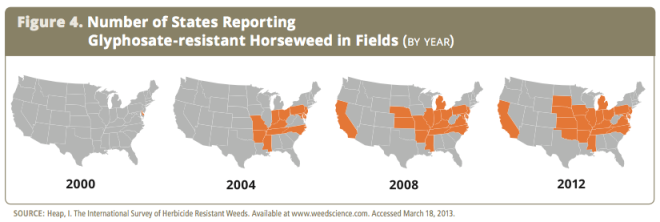
Now the problem is massive, and it’s resulting in ever-increasing use of Roundup/glyphosate, as well as many other herbicides, to try and bring the emerging weed pandemic under control.
The wave of resistant plant life is not being brought about by altered genes – the artificial means by which food and fiber crops were changed in the laboratory to make them Roundup Ready in the first place. It’s happening through a more direct and far more rapid process called “epigenetic” change, in which plants keep their genetic material intact, but alter the way their genes interact and change the sorts of essential proteins they produce. Epigenetic change happens quickly – over a few years or even less, compared to the minimum of a few hundred years required for natural genetic alterations.
In fact, it occurs, under the right conditions, just as fast as it takes clever scientists at companies like Monsanto to bring about genetic alterations by hi-tech means. (There could be a lesson here for us all!)
The ultimate in “no name brands”: the battle over labelling GMOs
Monsanto and its business partners – Dow, Dupont, Syngenta and the new centre of glyphosate manufacturing, China – are fully aware of the buildup of bad news around the chemical that once promised to bring them all untold wealth, forever.
The same is increasingly true for the tens of thousands of mostly large-scale farm operators, wholesalers, retailers and distributors who have come to rely on Roundup Ready crops.
The bad news is piling up, and worries and questions are multiplying.
This is certainly true for a growing segment of the general population, who have developed a high index of suspicion about corporate public relations in general, but are especially sensitive about information concerning the quality of the food they put in their mouths.
This is undoubtedly why Big Ag has so frantically resisted labeling of GE foods. In California in 2012, Monsanto contributed over $8 million to a final total of $46 million spent primarily by agribusiness corporations to defeat Proposition 37, a law that would have required labeling of GMOs. The supporters of the Proposition were able to muster just over $9 million.
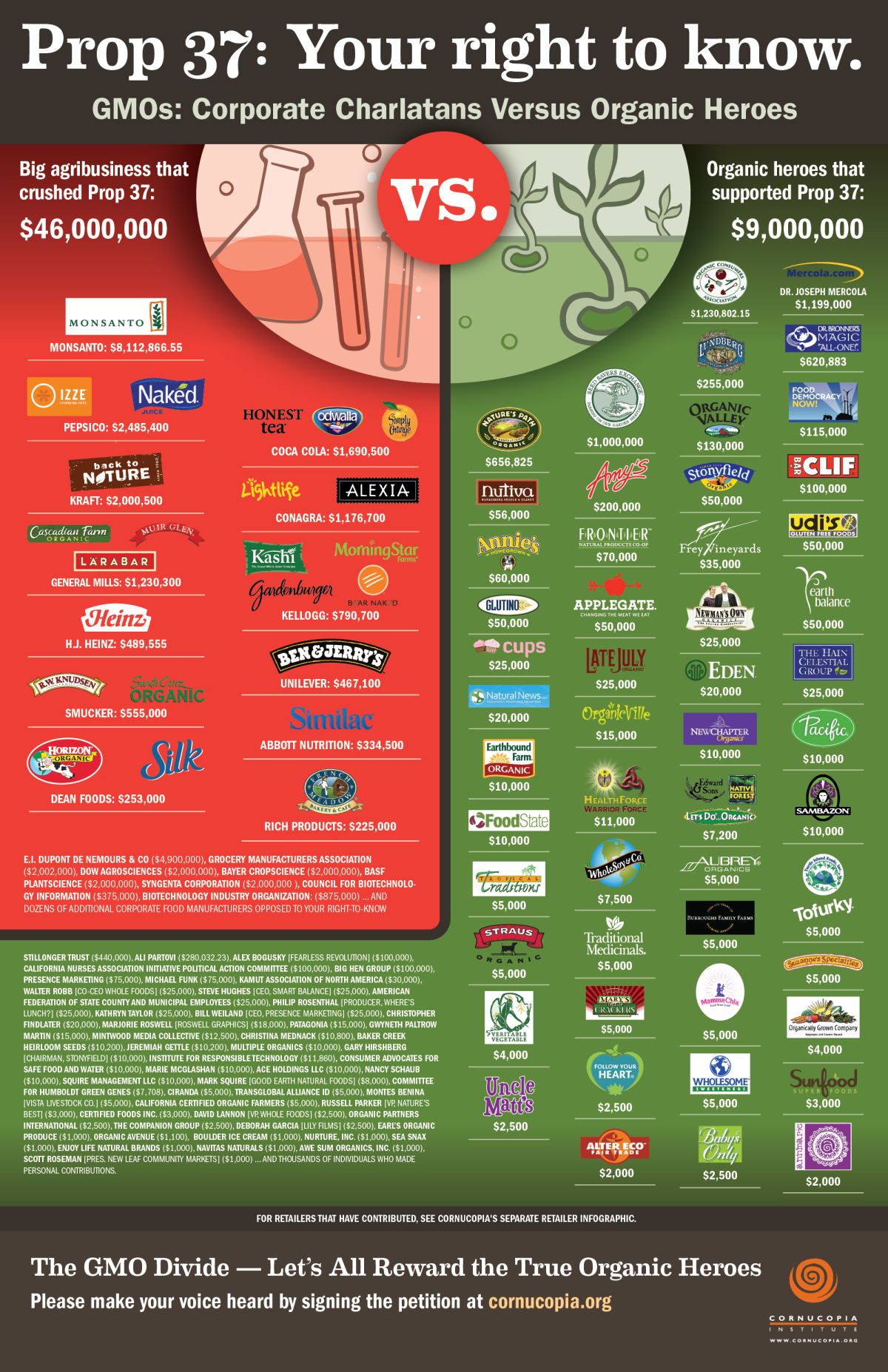
The lobby group for large agribusiness companies, Croplife, has aggressively opposed every other attempt to mandate labeling.
Over the years many reputable scientific voices, such as the American Association for the Advancement of Science, and the popular science magazine Scientific American, have come out against labelling of GMO’s, without betraying the slightest awareness of the problems caused by the pervasive link between GMO’s and glyphosate.
Yet is now clear that glyphosate residues exist on all Roundup Ready foods and in animals that eat them, and more and more evidence reveals the many disruptive effects of Roundup/glyphosate on living entities of all kinds.
Seeing this, it seems clear that Big Ag has decided that it can never allow labeling of GE foods, because the risk of allowing the identification of harms from glyphosate – the goose that laid the golden egg, and is still furiously depositing the precious metal – is too great.
Many citizens might reject GMOs simply because they are genetically engineered, but many more would unquestionably – and for more valid scientific reasons — refuse to consume food laced with a powerful chemical whose hazards are becoming ever more clearly delineated.
How will Monsanto's story end?
The handwriting is on the wall in large clear letters. It says that the world’s most widely used pesticide is headed for a fall.
As it goes down, its decline will potentially impact the entire approach to growing food as a form of chemical warfare.
This decline has been visible to thoughtful observers for a long time.
One early signal was the success of the Cuban experiment in organic agriculture, 90 miles off American shores, right under the nose of Big Ag.
In the setting of the insensate U.S. trade blockade of the island nation, and triggered by the collapse of the Soviet Union in 1989, Cuba’s Fidel Castro signed off on a massive restructuring of the Cuban economy and way of life.
A key part of this was a U-turn back to chemical-free agriculture – since pesticides and artificial fertilizers are mostly made of petroleum, and the Soviets had been the sole suppliers of oil to Cuba.

The result was the largest experiment in implementing organic agriculture on a mass scale ever seen.
It generated intense international interest, and ultimately, resounding international accolades, as Cuban food production, especially in the capital Havana, rose exponentially.
The revolution in food was firmly rooted in widespread and helpful educational programs, instead of commercial secrecy and clever public relations that are the order of the day in corporate-dominated economies. It also featured the distribution of inexpensive tools and seeds, not the sale of costly proprietary products.
In step with that exciting national adventure, widespread interest in the healthful character of organic food has also grown rapidly, resulting in a steady growth in sales of synthetic-chemical-free organic foods in Canada, the US and around the world. Now, many other countries are following Cuba’s lead, not out of the dire necessity that drove Cuba’s agricultural revolution, but as a result of high-quality modern science and widespread popular buy-in.
As with the intense struggle between cigarette smoking and non-smoking, or between burning fossil fuels and turning to renewable energy, the outcome of the struggle between agriculture conceived as a war against Nature and agriculture that follows ecological principles and rules is no longer in doubt.
Global society – and the planet that we have responsibility for – cannot and will not tolerate, for much longer, ways of life that are built around war and divisiveness and promoting one small part of the natural world over all others.
Science tells us what First Peoples around the world have tried to tell the rest of us for hundreds of years: Mother Nature bats last.
We don’t have a choice to play nice with the forces of the natural world. Doing so is a matter of survival.
Now is also not the time to condemn those who bought in to a narrow, partisan view of the world. Every one of us partook of that vision to some extent in past times.
But it most definitely is time to accelerate the process of transforming how we live, to bring it into balance with the web of life, to use the insights of science – and First Peoples’ empirical wisdom – to revivify the connection between humans and the natural world, and to acknowledge the value of all living things and of the inanimate world that sustains them and us.
In that world, the role of crude, harsh and destructive chemicals should have no place.
The last Roundup is coming.

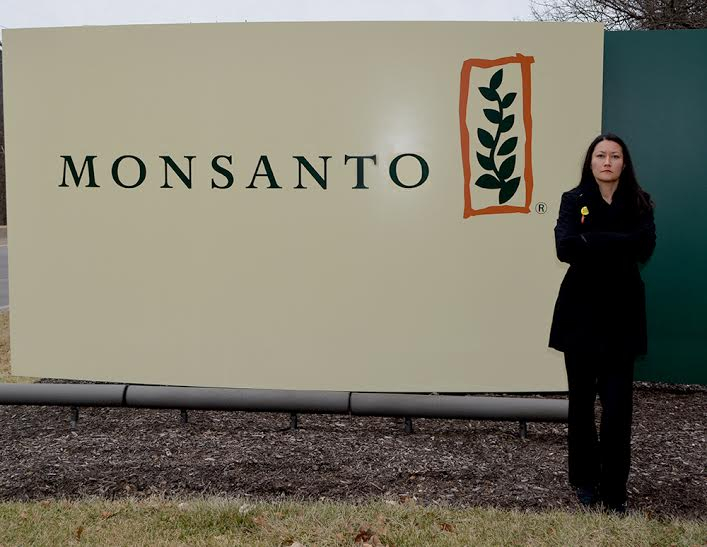



Comments